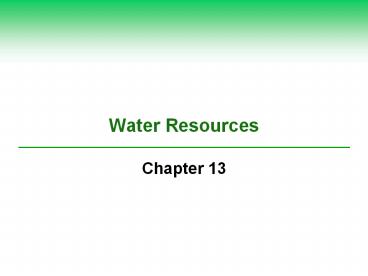Water Resources - PowerPoint PPT Presentation
1 / 19
Title:
Water Resources
Description:
Water Resources Chapter 13 Questions for Today Why is water so important? Does everyone have access to clean and healthy water Describe the three major zones of ... – PowerPoint PPT presentation
Number of Views:219
Avg rating:3.0/5.0
Title: Water Resources
1
Water Resources
- Chapter 13
2
Questions for Today
- Why is water so important?
- Does everyone have access to clean and healthy
water - Describe the three major zones of Groundwater.
- What are the major problems associated with
Freshwater in the US? - What is Drought and what are the problems
associated with Drought? - Who owns all the freshwater?
3
Freshwater Is an Irreplaceable Resource That We
Are Managing Poorly (1)
- Why is water so important?
- Earth as a watery world 71 (mostly Salt)
- 60 of yourself is made from water
- Freshwater availability 0.024
- Hydrologic cycle
- Movement of water in the seas, land, and air
- Driven by solar energy and gravity
- Water pollution
- Degradation of the Worlds Water Supply
- Partly Because its Cheap
- Taken For Granted
4
Freshwater Is an Irreplaceable Resource That We
Are Managing Poorly (2)
- Access to water is
- A global health issue
- Sanitation
- 1.6 million people died in 2007
- An economic issue
- Helps reduce poverty and produces food and energy
- A womens and childrens issue
- In developing countries, it is their job to carry
water back home - A national and global security issue
- Tension between shared resources
5
Girl Carrying Well Water over Dried Out Earth
during a Severe Drought in India
6
Most of the Earths Freshwater Is Not Available
to Us
- People divided into
- Water haves
- Those that have a readily availably clean and
healthy water supply - For instance
- Canada has 0.5 of the worlds people but has 20
of the worlds water - Water have-nots
- Those that do not access to clean, fresh water
- For instance
- China has 20 of the worlds people, but only 7
of the worlds supply of freshwater
7
We Get Freshwater from Groundwater and Surface
Water (1)
- Ground water
- Water found in the pores between soil, gravel and
rock held between an impenetrable rock layer - Zone of saturation
- The point at which the groundwater is completely
filled - Water table
- The Top of the Ground water zone
- Falls in dry weather or unsustainable harvesting
- Rises in Wet Weather
- Aquifers
- Natural recharge from precipitation and
percolation - Lateral recharge from a nearby river or stream
- Both Recharge slowly
8
We Get Freshwater from Groundwater and Surface
Water (2)
- Surface Water Most Important Water Resource
- Lakes, Rivers, Streams
- Surface runoff non-evaporated precipitation
- Watershed (drainage) basin
- A collection area for Surface water
9
Natural Capital Groundwater System Unconfined
and Confined Aquifer
10
Unconfined Aquifer Recharge Area
Evaporation and transpiration
Evaporation
Precipitation
Confined Recharge Area
Runoff
Flowing artesian well
Well requiring a pump
Stream
Water table
Infiltration
Lake
Infiltration
Unconfined aquifer
Less permeable material such as clay
Confined aquifer
Confining impermeable rock layer
Fig. 13-3, p. 316
11
We Use a Large and Growing Portion of the Worlds
Reliable Runoff
- 2/3 of the surface runoff lost by seasonal
floods - 1/3 runoff usable
- Domestic 10
- Agriculture 70
- Industrial use 20
- Fred Pearce, author of When the Rivers Run Dry
- Takes 450,000 liters or 2,400 bathtubs of water
to produce a car - 140 liters to produce a cup of coffee
- 25 bathtubs to produce a T-shirt
12
Case Study Freshwater Resources in the United
States
- More than enough renewable freshwater, unevenly
distributed - Eastern states have more rain than western and
southwestern states - The three rainiest cities are
- Mobile, AL
- Pensacola, FL
- New Orleans, LA
- What are the most serious water problems in the
US? - Floods
- Pollution
- Drought when precipitation is at least 70
lower and evaporation is higher than normal.
13
Average Annual Precipitation and Major Rivers,
Water-Deficit Regions in U.S.
14
Fig. 13-4a, p. 317
15
Fig. 13-4b, p. 317
16
Long-Term Severe Drought Is Increasing
- Causes
- Extended period of below-normal rainfall
- Diminished groundwater
- Harmful environmental effects
- Dries out soils
- Reduces stream flows
- Decreases tree growth and biomass
- Lowers net primary productivity and crop yields
- Shift in biomes
17
In Water-Short Areas Farmers and Cities Compete
for Water Resources
- 2007 National Academy of Science study
- Increased corn production in the U.S. to make
ethanol as an alternative fuel - Decreasing water supplies
- Aquifer depletion
- Increase in pollution of streams and aquifers
18
Who Should Own and Manage Freshwater Resources?
(1)
- Most water resources
- Owned by governments
- Managed as publicly owned resources
- Veolia and Suez French companies
- Buy and manage water resources
- Successful outcomes in many areas
19
Who Should Own and Manage Freshwater Resources?
(2)
- Bechtel Corporation
- Poor water management in Bolivia
- Potential problems with full privatization of
water resources - Financial incentive to sell water not conserve
it - Poor will still be left out































